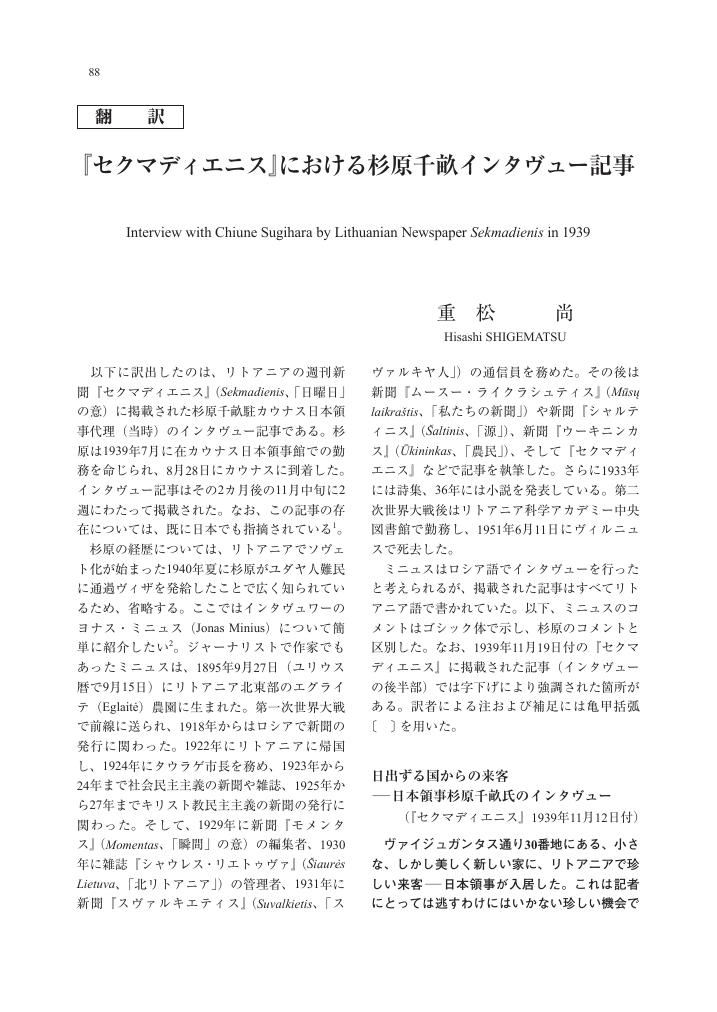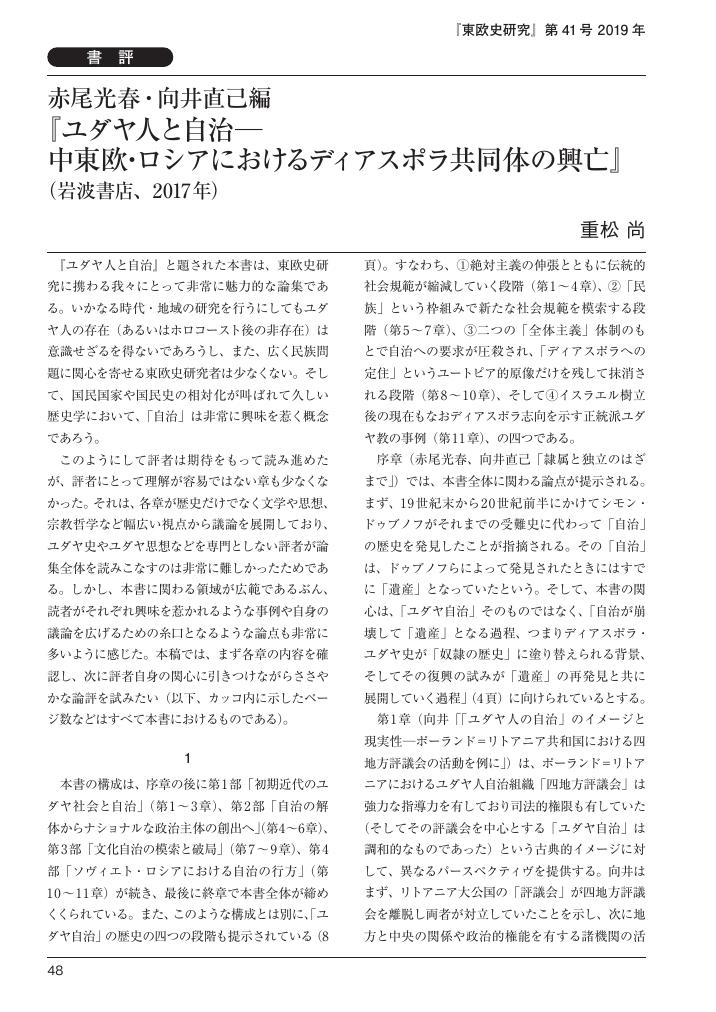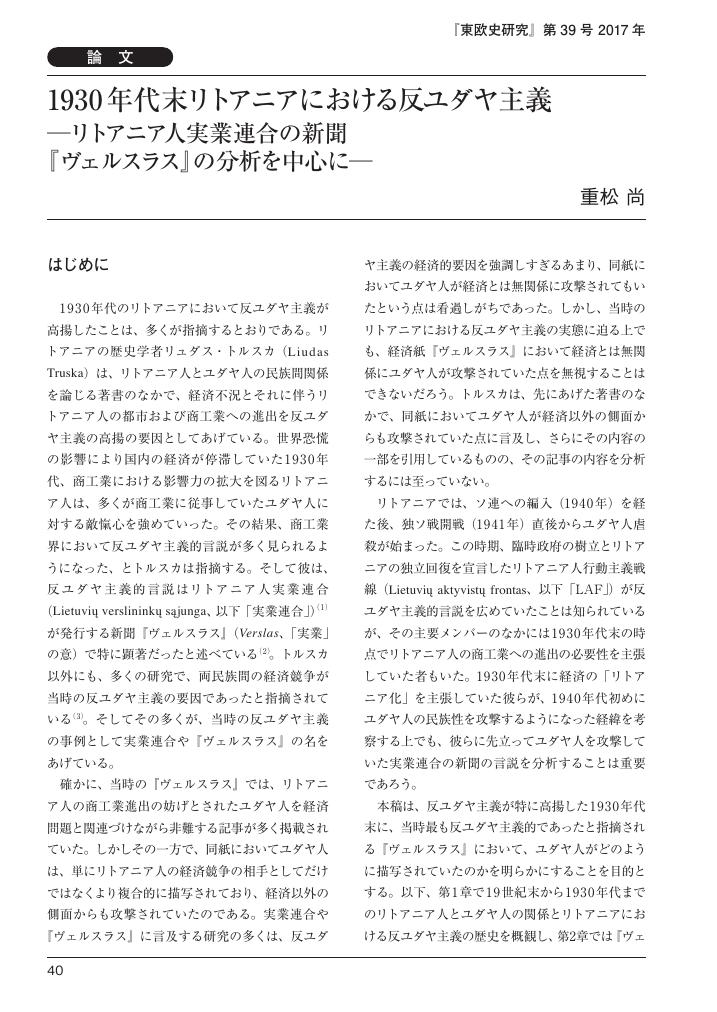2 0 0 0 OA ソ連・東欧におけるホロコーストの比較研究
- 著者
- 高尾 千津子 鶴見 太郎 野村 真理 武井 彩佳 宮崎 悠 井出 匠 小森 宏美 Wolff David 重松 尚
- 出版者
- 東京医科歯科大学
- 雑誌
- 基盤研究(B)
- 巻号頁・発行日
- 2016-04-01
独ソ戦によってナチの支配下におかれた地域のホロコーストの特徴は、ユダヤ人の殺害が現地で執行されたこと、ナチによる占領の初期段階で、現地住民の一部がユダヤ人に対するポグロムに関与したことに求められる。本研究は、ソ連・東欧におけるホロコーストの事例研究に取り組み、現地住民のナチ協力に関しては、新たにソ連の支配下に入ったバルト3国やポーランド東部地域とソ連本国内の東ベラルーシ等とで相違があることを明らかにした。
- 著者
- 重松 尚
- 出版者
- ユーラシア研究所
- 雑誌
- ロシア・ユーラシアの経済と社会 (ISSN:21858748)
- 巻号頁・発行日
- no.994, pp.31-45, 2015-06
1 0 0 0 OA 『セクマディエニス』における杉原千畝インタヴュー記事
- 著者
- 重松 尚
- 出版者
- 日本ユダヤ学会
- 雑誌
- ユダヤ・イスラエル研究 (ISSN:09162984)
- 巻号頁・発行日
- vol.32, pp.88, 2018 (Released:2021-05-09)
- 著者
- 重松 尚
- 出版者
- 一般財団法人 日本国際政治学会
- 雑誌
- 国際政治 (ISSN:04542215)
- 巻号頁・発行日
- vol.2021, no.202, pp.202_47-202_60, 2021-03-29 (Released:2022-03-31)
- 参考文献数
- 62
After the coup d’état in 1926, Lithuania was ruled by the authoritarian regime led by President Antanas Smetona. In the late 1930s, complaints about the Smetona government was grew, especially among the opposition groups, such as Voldemarininkai, the Populists (liaudininkai) and the Christian Democrats, because they considered that Smetona government’s “neutral” foreign policies led to the ultimatum by Poland in 1938. Thus, they established a unified anti-Smetona movement “Lithuanian Activists Union” (LAS) in 1938 in Klaipėda (Memel) and criticized the authoritarian government as dictatorship. They aimed to establish a Fascism regime in Lithuania instead, as they believed that, under the Fascism regime, the whole Lithuanian nation could be involved in the policy decision making. They, nevertheless, considered the Jews and communists were “anti-national”, thus tried to exclude them. LAS pursued some democratic values, such as freedom of the press and free elections, but they criticized parliamentary democracy since they believed that it led to a split of the nation. They aimed at close relations with Nazi Germany and state-planned economy. They believed that such “Disciplined Authoritarian Democracy” should have replaced the Smetona-led authoritarian regime.
- 著者
- 重松 尚
- 出版者
- 東欧史研究会
- 雑誌
- 東欧史研究 (ISSN:03866904)
- 巻号頁・発行日
- vol.41, pp.48-53, 2019 (Released:2022-06-09)
- 著者
- 重松 尚
- 出版者
- 東欧史研究会
- 雑誌
- 東欧史研究 (ISSN:03866904)
- 巻号頁・発行日
- vol.39, pp.40-63, 2017 (Released:2022-02-12)
- 著者
- 重松 尚
- 出版者
- 東欧史研究会
- 雑誌
- 東欧史研究 = The Journal of East European studies (ISSN:03866904)
- 巻号頁・発行日
- no.39, pp.40-63, 2017-03


